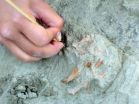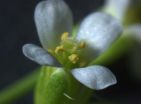(Press-News.org) Around 450 million years ago, shallow seas covered the Cincinnati region and harbored one very large and now very mysterious organism. Despite its size, no one has ever found a fossil of this "monster" until its discovery by an amateur paleontologist last year.
The fossilized specimen, a roughly elliptical shape with multiple lobes, totaling almost seven feet in length, will be unveiled at the North-Central Section 46th Annual Meeting of the Geological Society of America, April 24, in Dayton, Ohio. Participating in the presentation will be amateur paleontologist Ron Fine of Dayton, who originally found the specimen, Carlton E. Brett and David L. Meyer of the University of Cincinnati geology department, and Benjamin Dattilo of the Indiana University Purdue University Fort Wayne geosciences faculty.
Fine is a member of the Dry Dredgers, an association of amateur paleontologists based at the University of Cincinnati. The club, celebrating its 70th anniversary this month, has a long history of collaborating with academic paleontologists.
"I knew right away that I had found an unusual fossil," Fine said. "Imagine a saguaro cactus with flattened branches and horizontal stripes in place of the usual vertical stripes. That's the best description I can give."
The layer of rock in which he found the specimen near Covington, Kentucky, is known to produce a lot of nodules or concretions in a soft, clay-rich rock known as shale.
"While those nodules can take on some fascinating, sculpted forms, I could tell instantly that this was not one of them," Fine said. "There was an 'organic' form to these shapes. They were streamlined."
Fine was reminded of streamlined shapes of coral, sponges and seaweed as a result of growing in the presence of water currents.
"And then there was that surface texture," Fine said. "Nodules do not have surface texture. They're smooth. This fossil had an unusual texture on the entire surface."
For more than 200 years, the rocks of the Cincinnati region have been among the most studied in all of paleontology, and the discovery of an unknown, and large, fossil has professional paleontologists scratching their heads.
"It's definitely a new discovery," Meyer said. "And we're sure it's biological. We just don't know yet exactly what it is."
To answer that key question, Meyer said that he, Brett, and Dattilo were working with Fine to reconstruct a timeline working backward from the fossil, through its preservation, burial, and death to its possible mode of life.
"What things had to happen in what order?" Meyer asked. "Something caused a directional pattern. How did that work? Was it there originally or is it post-mortem? What was the burial event? How did the sediment get inside? Those are the kinds of questions we have."
It has helped, Meyer said, that Fine has painstakingly reassembled the entire fossil. This is a daunting task, since the large specimen is in hundreds of pieces.
"I've been fossil collecting for 39 years and never had a need to excavate. But this fossil just kept going, and going, and going," Fine said. "I had to make 12 trips, over the course of the summer, to excavate more material before I finally found the end of it."
Even then he still had to guess as to the full size, because it required countless hours of cleaning and reconstruction to put it all back together.
"When I finally finished it was three-and-a-half feet wide and six-and-a-half feet long," Fine said. "In a world of thumb-sized fossils that's gigantic!"
Meyer, co-author of A Sea without Fish: Life in the Ordovician Sea of the Cincinnati Region, agreed that it might be the largest fossil recovered from the Cincinnati area.
"My personal theory is that it stood upright, with branches reaching out in all directions similar to a shrub," Fine said. "If I am right, then the upper-most branch would have towered nine feet high. "
As Meyer, Brett and Dattilo assist Fine in studying the specimen, they have found a clue to its life position in another fossil. The mystery fossil has several small, segmented animals known as primaspid trilobites attached to its lower surface. These small trilobites are sometimes found on the underside of other fossilized animals, where they were probably seeking shelter.
"A better understanding of that trilobite's behavior will likely help us better understand this new fossil," Fine said.
Although the team has reached out to other specialists, no one has been able to find any evidence of anything similar having been found. The mystery monster seems to defy all known groups of organisms, Fine said, and descriptions, even pictures, leave people with more questions than answers.
The presentation April 24 is a "trial balloon," Meyer said, an opportunity for the team to show a wide array of paleontologists what the specimen looks like and to collect more hypotheses to explore.
"We hope to get a lot of people stopping by to offer suggestions," he said.
In the meantime, the team is playing around with potential names. They are leaning toward "Godzillus."
### END
Mysterious 'monster' discovered by amateur paleontologist
2012-04-25
ELSE PRESS RELEASES FROM THIS DATE:
'Inhabitants of Madrid' ate elephants’ meat and bone marrow 80,000 years ago
2012-04-25
Humans that populated the banks of the river Manzanares (Madrid, Spain) during the Middle Palaeolithic (between 127,000 and 40,000 years ago) fed themselves on pachyderm meat and bone marrow. This is what a Spanish study shows and has found percussion and cut marks on elephant remains in the site of Preresa (Madrid).
In prehistoric times, hunting animals implied a risk and required a considerable amount of energy. Therefore, when the people of the Middle Palaeolithic (between 127,000 and 40,000 years ago) had an elephant in the larder, they did not leave a scrap.
Humans ...
ORNL, Yale take steps toward fast, low-cost DNA sequencing device
2012-04-25
Researchers at Oak Ridge National Laboratory and Yale University have developed a new concept for use in a high-speed genomic sequencing device that may have the potential to substantially drive down costs.
"The low cost--if it can be achieved--would enable genomic sequencing to be used in everyday clinical practice for medical treatments and preventions," said Predrag Krstic, project director and former ORNL physicist now at the University of Tennessee-ORNL Joint Institute for Computational Sciences.
The research is part of a nearly decade-long drive by the National ...
Soy-based S-equol supplement reduces hot flash frequency, muscle & joint pain in US women
2012-04-25
Northridge, Calif. (April 24, 2012) – A dose of 10 milligrams (mg) daily of S-equol delivered via a newly developed fermented soy germ-based nutritional supplement is as effective as a standard dose of soy isoflavones at reducing hot flash frequency significantly and is even more effective for relieving muscle and joint pain, according to a peer-reviewed study in US postmenopausal women published in the June Journal of Women's Health, available now as a Fast Track article online ahead of print.
"This study provides evidence that daily doses of the supplement S-equol, ...
Molecule movements that make us think
2012-04-25
VIDEO:
A research group at Linköping University has built five different molecular models of the voltage sensor in an ion channel, which together can explain all the experimental data. The five...
Click here for more information.
Every thought, every movement, every heartbeat is controlled by lightning-quick electrical impulses in the brain, the muscles, and the heart. But too much electrical excitability in the membranes of the cells can cause things like epilepsy and cardiac ...
PNAS: Precise molecular surgery in the plant genome
2012-04-25
This press release is available in German.
The new method is based on the natural repair mechanism of plants. So-called homologous recombination repairs the genome when the genome strands in the cell break. "Using an appropriate enzyme, i.e. molecular scissors, we first make a cut at the right point in the genome and then supply the necessary patch to repair this cut," says Friedrich Fauser from Karlsruhe Institute of Technology, who is the first author of the PNAS publication. "A part of this patch is the new gene piece we want to install. The rest is done by the ...
The search for a job begins and ends with you
2012-04-25
Staying motivated is always tough, but it certainly gets easier when you start seeing results. That's why keeping your spirits up during a job search can be extremely difficult. Candidates often face repeated rejection and rarely receive any feedback. A new study that focuses on finding work following a job layoff reveals just how important managing negative thoughts and effort over time are while looking for employment.
The research shows that having a more positive, motivational outlook had a beneficial effect on job pursuit, especially at the outset of the search. ...
Family history of liver cancer increases risk of developing the disease
2012-04-25
A family history of liver cancer is reported to increase risk of developing hepatocellular carcinomas (HCC), independent of hepatitis according to findings published in the May issue of Hepatology, a journal of the American Association for the Study of Liver Diseases. The study also shows 70-fold elevated risk of HCC in those with liver cancer in the family and markers for hepatitis B (HBV) or hepatitis C (HCV).
Liver cancer ranks sixth in incidence and the third cause of mortality worldwide. According to the World Health Organization (WHO) liver cancer was responsible ...
Fibrosis and fatty liver disease increase risk of early atherosclerosis
2012-04-25
Italian researchers report that severe fibrosis increases the early atherosclerosis risk in patients with genotype 1 chronic hepatitis C virus (HCV) infection. A second study found that fatty liver disease also increases risk of developing atherosclerosis at an earlier period. Both studies appear in the May issue of Hepatology, a journal published by Wiley-Blackwell on behalf of the American Association for the Study of Liver Diseases.
In the first study, researchers led by Dr. Salvatore Petta from the Di.Bi.M.I.S. University of Palermo in Italy evaluated 174 patients ...
Bile – not acid – is bad guy in triggering precancerous condition associated with reflux disease
2012-04-25
For many people with gastroesophageal reflux disease or GERD, acid reflux drugs are the answer to their woes, curbing the chronic heartburn and regurgitation of food or sour liquid characteristic of the disorder. But when it comes to Barrett's esophagus, a condition commonly found in people with GERD, acid control may be less important than beating back another bodily fluid – bile.
A new study published in the Annals of Surgery shows that bile – a digestive fluid that leaks backwards from the stomach into the esophagus along with acid in patients with GERD – plays a ...
Improving on the amazing: Ames Laboratory scientists seek new conductors for metamaterials
2012-04-25
AMES, Iowa -- Scientists at the U.S. Department of Energy's Ames Laboratory have designed a method to evaluate different conductors for use in metamaterial structures, which are engineered to exhibit properties not possible in natural materials. The work was reported this month in Nature Photonics.
Cloaking devices that hide planes from RADAR, microscopes that can see inside a single cell, and miniature antennae that measure only a few millimeters all sound like parts of a science fiction movie. But, within the span of the decade since they began their work, Ames Laboratory ...


